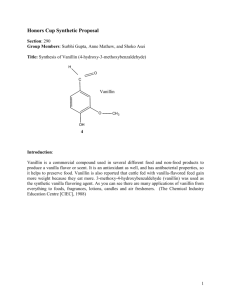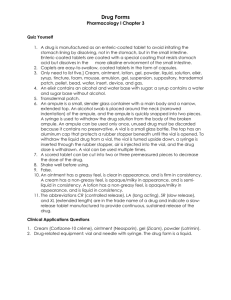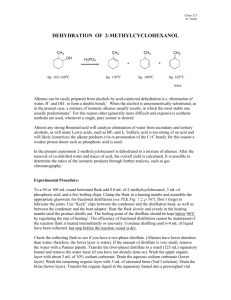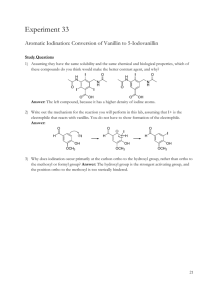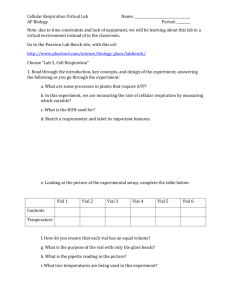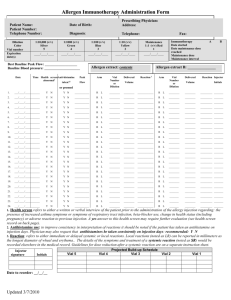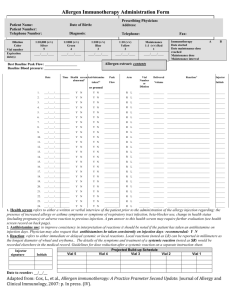Vanillin Synthesis from 4-Hydroxybenzaldehyde Article
advertisement
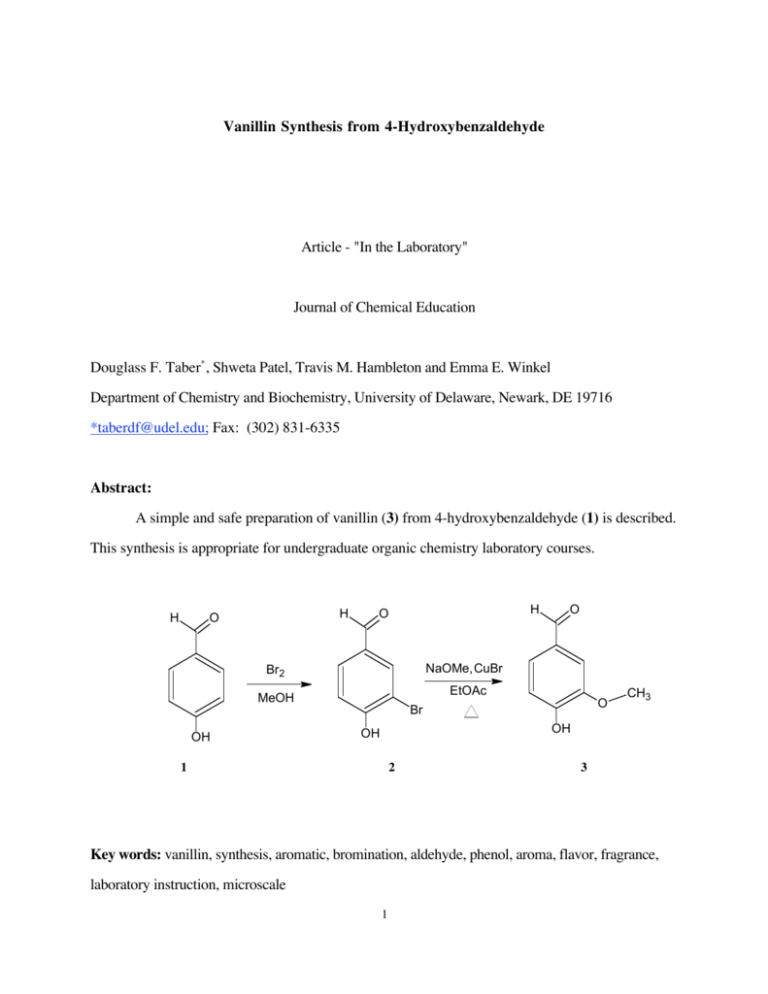
Vanillin Synthesis from 4-Hydroxybenzaldehyde Article - "In the Laboratory" Journal of Chemical Education Douglass F. Taber* , Shweta Patel, Travis M. Hambleton and Emma E. Winkel Department of Chemistry and Biochemistry, University of Delaware, Newark, DE 19716 *taberdf@udel.edu; Fax: (302) 831-6335 Abstract: A simple and safe preparation of vanillin (3) from 4-hydroxybenzaldehyde (1) is described. This synthesis is appropriate for undergraduate organic chemistry laboratory courses. H H O H O NaOMe,CuBr Br2 EtOAc MeOH OH O O Br CH3 OH OH 1 2 3 Key words: vanillin, synthesis, aromatic, bromination, aldehyde, phenol, aroma, flavor, fragrance, laboratory instruction, microscale 1 Vanillin Synthesis from 4-Hydroxybenzaldehyde Douglass F. Taber*, Shweta Patel, Travis M. Hambleton, and Emma E. Winkel Department of Chemistry and Biochemistry, University of Delaware Newark, DE 19716 Lab Summary: The fragrance of vanilla is familiar to the undergraduate student. The safe and efficient preparation described here proceeds in two steps (Scheme 1), the bromination of 4hydroxybenzaldehyde 1 to give 3-bromo-4-hydroxybenzaldehyde 2, and the Cu-mediated coupling of 2 with methoxide to give 3. The regioselectivity of the first step illustrates classic electrophilic aromatic substitution, while the second step is a more modern transition metal-catalyzed bond forming reaction. The chromatographic purification of synthetic 3 is straightforward, and the student is rewarded both by the crystallinity, and by the sweet fragrance of the product. The vanillin so prepared can be further purified by recrystallization from water. Scheme 1: H H O H O NaOMe,CuBr Br2 EtOAc MeOH OH 1 O O Br OH OH 2 3 CH3 If desired, this experiment also lends itself to more extensive background exploration by the student. Vanillin 3, a naturally occurring aromatic compound in vanilla beans, is used in a wide range from flavoring foods and medicine to perfumes. It is also associated with the paper industry, for it can be produced from lignin, and is a product of the biodegradation of eugenol and ferulic 2 acid. Natural vanilla extract is expensive, so synthetic vanillin is in large demand for its variety of uses. It can be synthesized from wood (1), from glucose (2), and by enzymatic processes (3). The experiment itself is in two parts. It is difficult to obtain pure 2 since the initial monobromo product 2 disproportionates easily to starting material and 3,5-dibromo-4-hydroxybenzaldehyde. Hence, the bromination is carried out for just 30 seconds and the reaction mixture is then carried directly on to the next step. The Br is replaced with OCH3 in the presence of copper catalyst via a pathway that probably involves oxidative addition and reductive elimination (4). This experiment is designed to be carried out in two 5 mL conical vials, one for each of the two reactions. Starting with 100 mg of 1, the student will routinely isolate more than 50 mg of solid vanillin 3. Hazards Handle the bromine solutions with extreme care since they are very toxic and the vapors are dangerous. They should remain in the fume hood as much as possible. Also be careful with the silica gel. Inhaling the dust could irritate the lungs, and so the silica gel too must be handled in the fume hood. Acknowledgments The authors thank the several other undergraduates who worked on this project since its inception, and the University of Delaware Honors Program for its support of this work. Supplemental Material Instructions for the students and notes for the instructor are available in this issue of JCE Online. Literature Cited 1. For previous undergraduate preparations of vanillin, from wood derivatives, see (a) Lampman, G. M.; Andrews, J.; Bratz, W.; Hanssen, O.; Kelley, K.; Perry, D.; Ridgeway, A. J. Chem.Educ. 1977, 54, 776. (b) Hocking, M. B. J. Chem.Educ. 1997, 74, 1055. 2. Li, K.; Frost, J. W. J. Am. Chem. Soc. 1998, 120, 10545. 3 3. van den Heuvel, R. H. H.; Fraaije, M. W.; Laane, C.; van Berkel, W. J. H. J. Agric. Food Chem. 2001, 49, 2954. 4. (a) For the original report of this preparation of vanillin, see Nobel, D. J. Chem. Soc., Chem. Commun. 1993, 419. (b) For a variation on the Cu-mediated methoxide coupling, see Capdevielle, P.; Maumy, M. Tetrahedron Lett. 1993, 34, 1007. 4 Lab Documentation Instructions to Students Vanillin Synthesis from 4-hydroxybenzaldehyde Preparation: You are to obtain two 5 mL reaction vials and label them A and B. Vial A will be used for the bromination reaction while B will be used for the second step of the synthesis. Vial A: Transfer 1.6 mL (0.80 mmol) of 0.5 M Br2 -MeOH mixture to vial A and place it in an icewater bath. Vial B: Clamp reaction vial B to a stand and add 1.4 mL (5.6 mmol) of 4.0 M NaOMe/MeOH (Note 1), 0.1 mL ethyl acetate (“EtOAc”), and 0.080 g (0.56 mmol) of Cu(I)Br. Measure and transfer the small amount of solutions with a plastic syringe. Be sure to cap this vial with a septum cap and insert a small needle attached to a 10 mL plastic syringe Open plastic syringe barrelvial cap with septumOil bath 130oNeedle above the solution lev Fig 1: Sample set-up of the reaction 5 without a plunger. The needle must not touch the contents of the vial. This way the evaporating solvent can be collected in the syringe. Heat this mixture in vial B in a 130 o C silicon oil bath in a fume hood for about 5-7 minutes. Please refer to Figure 1 for set-up. Running the reaction: To the Br2 -MeOH mixture in vial A, add 100 mg (0.82 mmol) of 4-hydroxybenzaldehyde, cap the vial and shake in ice-water bath for 30 seconds. Remove the caps of both vials and pour the contents of vial A into the already-hot contents of vial B (Note 2). Replace the cap with the syringe barrel on vial B and heat this mixture in the 130 o C silicon oil bath in a fume hood for one hour. During this time, prepare a flash chromatography column using 5.0 g of flash silica gel. You should also prepare the solvent to be used in the column by combining 30 mL of Et2 O and 170 mL of petroleum ether in a 250 mL Erlynmeyer flask. By the end of the hour, most of the solvent that was in vial B will have collected in the syringe barrel and a dark brown residue will remain in vial B. Remove vial B from the heat source and let it stand until it is cool. Do not burn yourself! Remove the cap from vial B. Using a total of 6 mL of 3.0 M aqueous HCl and gently scraping the solid using a spatula, transfer the contents of vial B to a separatory funnel. Extract with 3x 5 mL EtOAc, (a small separatory funnel or a centrifuge tube and a pipette may be used), combine the organic extracts and dry with Na2 SO4 . Transfer the supernatant to a round-bottom flask, add 0.5 g silica gel and place the flask on a rotary evaporator to remove excess solvent, leaving a dry light brown powder. Preparing a column: For detailed instructions on flash chromatography, see Reference 5. To prepare the column, place a small wad of glass wool in the bottom of a 19 mm diameter chromatography column, and cover with a thin layer of sand. On this sand layer, add the 5 grams of flash silica gel, and gently tap the column to level the silica gel. Transfer your sample (the light brown powder) from the round-bottom flask on top of this layer. Finish by adding another thin layer of sand.5 6 Running the column: Elute the column with Et2 O/petroleum ether (“PE”) (30 mL/170 mL, total 200 mL) as the solvent, and collect thirty-five 5 mL fractions. Vanillin is usually found in fractions 21-30. Check the fractions via TLC; the TLC solvent should be 4 mL of diethyl ether (“Et2 O”)/6 mL of PE. At the origin of a TLC plate, you should make three spots side by side. The first spot should be of the starting material, 4-hydroxybenzaldehyde, dissolved in ether. The second spot should be of the column fraction, and the third spot should be of authentic vanillin. Combine the fractions containing pure vanillin and evaporate the solvent. At this stage, the product yield should be about 74% and the melting point range should be 82 - 85 o C. The vanillin so prepared can be further purified by crystallization. Crystallization: Heat 10 mL of deionized water to boiling in a 25 mL Erlenmeyer flask and carefully scrape the product from the column into the hot water. To ensure maximum transfer, pipet some of the hot water into the round-bottom flask and swirl it gently. Carefully transfer this water back into the Erlenmeyer flask. Continue heating the water for another 10 minutes. Meanwhile, set up a 25 mL Erlenmeyer filter flask for suction filtration and on it, place a no-neck 2.5 cm glass funnel with a filter paper folded in the shape of a cone. Pour the hot water through the funnel, making sure that the water level in the funnel does not rise above the level of the filter paper. Remove the funnel and the filter paper, cover the flask, and place it in an ice-water bath, or leave it until the next laboratory session. White vanillin crystals will be visible in water within the next few hours. In the next laboratory session filter the suspension and rinse the crystals with 15 mL of cold deionized water. Collect the crystals on filter paper and let them air-dry until the third laboratory session. Be sure to store the crystals in a safe place so they will not be spilled or contaminated. Obtain the weight of the product, the percent yield and melting point range. You should expect the product yield to be about 70%. Pure vanillin melts at 81-83o C. 7 Safety notes: Handle the bromine solutions with extreme care since they are very toxic and the vapors are dangerous. They should remain in the fume hood as much as possible. Also be careful with the silica gel. Inhaling the dust could irritate the lungs, and so the silica gel too must be handled in the fume hoods. The sodium methoxide solution is very water sensitive. After each use, be sure to reseal the container immediately. 8 Instructor Notes: Note 1: The instructor should prepare the NaOMe solution (preparation time of about two hours) and Br2 -MeOH mixture in advance since these chemicals are very toxic. The solutions are best handled using pipetters with plastic tips. There is no need to change the plastic tip between students, but it should be changed (and properly disposed of) between sections. Each solution, and the ethyl acetate, should have its own pipetter, or even better, more than one, since the students will all be using them at the same time. Alternatively, the two vials for each student can be prepared by the instructor ahead of time. Note 2: This reaction can also be done in a round-bottom flask with an air condenser, without the syringe barrel. Either way, the solvent is slowly removed from the reaction. With the air condensor, the solvent just evaporates. Note 3: The second step, heating the vial, is best done in a silicon oil bath. There is no need to stir the reactions, but the oil bath should be stirred. We have found it most convenient for each vial to have its own clamp, arranged in a circle around the oil bath. The vials should be about halfway immersed in the hot oil. The instructor should have the oil bath(s) hot and ready to go before the section meets, since the students will be heating their vials right away. The instructor may also choose to set up the clamps appropriately ahead of time. Note 4: While the vials heat, the students should prepare their chromatography columns and test tubes to receive fractions. They can also practice TLC of the starting material and vanillin, using samples or solutions provided by the instructor. Note 5: 1 H NMR spectra of the starting material and of vanillin are attached. 9 Amounts for 15 students: • 4-hydroxybenzaldehyde: 2 grams • 4 M NaOMe solution: 25 mL • 0.5 M Br2 -MeOH mixture: 25 mL • CuBr: 1.5 grams • EtOAc: 2 mL • 3 M HCl: 100 mL • De-ionized water: 200 mL • Petroleum ether: 3 L • Et2 O: 500 mL • Flash silica gel: 85 g • TLC plates (microscope slide size): 150 • 10 mL plastic disposable syringe: 15 • Wheaton 5 mL reactivials: 30 (reusable) • Septa caps with Teflon-faced septa for the above: 30 (caps can be re-used, septa should not be. 10 Sample Pre-Lab Questions 1. Name a commercial product, other than vanilla extract, that contains vanillin. 2. Draw out the mechanism for electrophilic bromination of 4-hydroxybenzaldehdye. 3. Draw out the mechanism for the acid-catalyzed conversion of 2 molecules of 3-bromo-4hydroxybenzaldehyde to one molecule of 4-hydroxybenzaldehyde and one molecule of 3,5dibromo-4-hydroxybenzaldehyde. 4. In a separatory funnel with ether and 5% aqueous NaOH, which layer would contain vanillin? Explain in detail. 5. If you were to spill bromine solution on your skin, what action, in addition to washing with soap and water, should you take to minimize damage? 11 Answers to Sample Pre-Lab Questions 1. Name a commercial product, other than vanilla extract, that contains vanillin. There are many, including Nilla wafers and cream soda. 2. Draw out the mechanism for electrophilic bromination of 4-hydroxybenzaldehdye. H O H O H Br Br H H O H O + HBr Br Br Br O H O 3. Draw out the mechanism for the acid-catalyzed conversion of 2 molecules of 3-bromo-4hydroxybenzaldehyde to one molecule of 4-hydroxybenzaldehyde and one molecule of 3,5dibromo-4-hydroxybenzaldehyde. H O H H Br O H H H Br H O Br Br Br O H H O O H - HBr + H H O O O - Br Br H O Br O H Br Br O H 4. In a separatory funnel with ether and 5% aqueous NaOH, which layer would contain vanillin? Explain in detail. ether H2O The phenol would be ionized by the NaOH, so it would be in the lower (water) layer. 12 5. If you were to spill bromine solution on your skin, what action, in addition to washing with soap and water, should you take to minimize damage? Wash the area with sodium bisulfite or sodium thiosulfate. 13 CAS Registry numbers: 4-hydroxybenzaldehyde, 123-08-0; bromine, 7726-95-6; 3-bromo-4hydroxybenzaldehyde, 2973-78-6; CuBr, 7787-70-4; methanol, 67-56-1; sodium methoxide, 12441-4; vanillin, 121-33-5. References: 1. For previous undergraduate preparations of vanillin, from wood derivatives, see (a) Lampman, G. M.; Andrews, J.; Bratz, W.; Hanssen, O.; Kelley, K.; Perry, D.; Ridgeway, A. J. Chem.Educ. 1977, 54, 776. (b) Hocking, M. B. J. Chem.Educ. 1997, 74, 1055. 2. Li, K.; Frost, J. W. J. Am. Chem. Soc. 1998, 120, 10545. 3. van den Heuvel, R. H. H.; Fraaije, M. W.; Laane, C.; van Berkel, W. J. H. J. Agric. Food Chem. 2001, 49, 2954. 4. (a) For the original report of this preparation of vanillin, see Nobel, D. J. Chem. Soc., Chem. Commun. 1993, 419. (b) For a variation on the Cu-mediated methoxide coupling, see Capdevielle, P.; Maumy, M. Tetrahedron Lett. 1993, 34, 1007. 5. Taber, D. F. ; Wang, Y. ; Liehr, S. J. Chem. Ed. 1996, 73, 1042-1043 14
